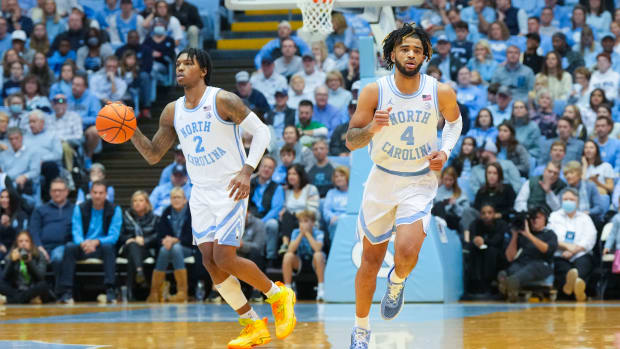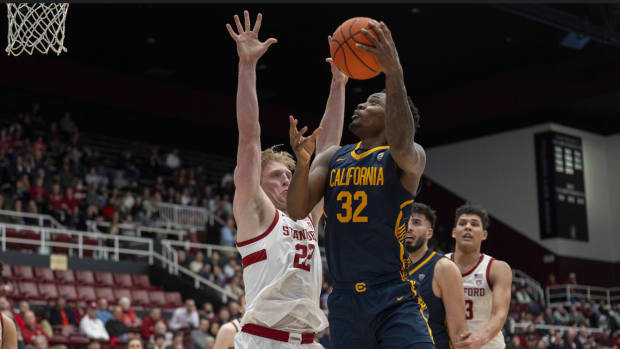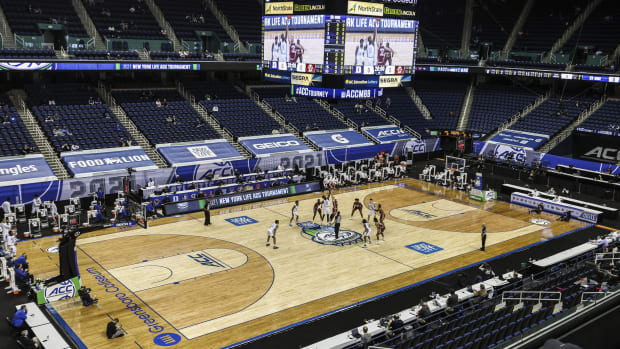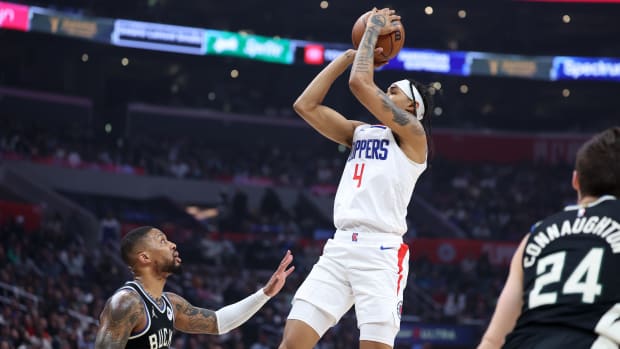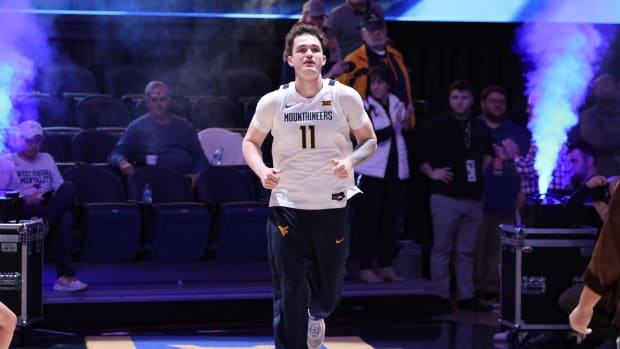
Conference catch-up: Pac-12
The loss of Mark Lyons will be felt by Sean Miller's Wildcats, but they still look to be the class of the Pac-12. (Streeter Lecka/Getty Images)
In today’s college sports landscape, having a spring where the biggest story is a referee coordinator being ousted is definitely a good thing. West Coast basketball is very much on the rebound, with significant high school prospects filling up the next several classes, and the Pac-12 coming back from a couple of very down years with a solid 2012-13 campaign. Five teams made the NCAAs, with both Oregon and Arizona making the Sweet 16. Things could be even better in 2013-14, as the ceiling on the best teams in the league seems higher and the quality of depth should be the same or better as in last season’s very competitive version.
Game Changer
The coaching turnover at both L.A. schools will create an interesting dynamic to watch. Not only will Andy Enfield and Co. try to shift pecking order against Steve Alford’s Bruins, but the new head men will provide opportunities for L.A.-area talent to stay at home. It’s no secret that Ben Howland had burned many bridges in the city’s recruiting pipeline, and no one really wanted to play for Kevin O’Neil at USC. That dynamic allowed other schools (in the league and otherwise) to get their hooks into Southern California recruiting. Alford’s contract will ensure he’s with the Bruins for at least half a decade and Dunk City West is just getting fired up at the Galen Center. With the concurrent improvement in prep talent in the area, having the L.A. schools once again as realistic options may have a significant impact across the league.
Player to Watch
There are a lot of ways to go here. Arizona has some excellent talent, perhaps headlined by incoming freshman Aaron Gordon, a top-five national recruit. Colorado’s Spencer Dinwiddie should challenge for league player of the year honors. There are a number of exciting guards to watch, including Jordan Adams, Jahii Carson, Dominic Artis, Chasson Randle, C.J. Wilcox and Justin Cobbs.
But the pick here is Wildcats point guard T.J. McConnell, who will only be asked to step in as a transfer to orchestrate a loaded team that has national title aspirations. Last season, Sean Miller rode Mark Lyons for as much as the Xavier import could give him (which was a good amount), but Lyons was not a point guard, at least of the kind that makes everything flow and everyone else better around him.
McConnell is a pass-first point guard who also was an excellent three-point shooter at Duquesne. He’s also a dogged on-ball defender, which is a key to Arizona’s defensive posture. A couple other transfers nationally may end up with bigger numbers or more headlines, but none may be more important to the team’s potential than McConnell, who should be ready after sitting out last year.
Current Favorite
Arizona is the proper pick given the sheer amount of talent that has come in the last two seasons, the quality of Sean Miller as a head coach, and the fact they have the right kind of lead guard this season. The gap between the Cats and some other potential challengers, though, is not nearly as great as a lot of others believe. The losses of Solomon Hill, Kevin Parrom and Lyons will be felt as the Cats try to live up to billing. On paper, they look incredibly imposing (and big), but getting a bunch of freshmen and sophomores together to meet expectations isn’t the surest bet in the world.
Presumed Challenger(s)
Oregon may end up being the biggest threat to the Wildcats, despite an assumed adjustment from a frontcourt-dominant approach to one that will be even more wide-open and guard-intense. If the Ducks can get enough up front from Ben Carter, Waverly Austin and their juco transfers and freshmen, they have the perimeter talent and the style to create a lot of problems in the league. The other best bet may be Colorado, which basically returns everyone significant from last season save for Andre Roberson, and the Buffaloes have more than enough cover with Xavier Johnson and Wesley Gordon to fill that hole. If Josh Scott takes a sophomore leap (especially in physicality) and Askia Booker is more prudent with his shot selection, this could be a very, very good team. Colorado’s quality depth will be a factor, especially at home in Boulder.
Potential Darkhorse(s)
UCLA still has a number of good pieces, most notably underappreciated Jordan Adams, whose ankle injury derailed the Bruins’ NCAA tournament hopes. He’s a tremendous volume scorer, and with Kyle Anderson, gives Alford two very nice building blocks. Arizona State should be a handful with Jahii Carson and agile 7-footer Jordan Bachynski. Getting Penn State transfer Jermaine Marshall eligible immediately will help ease the loss of the multidimensional Carrick Felix. Stanford returns a lot of last season’s core that was expected to do better. Josh Huestis and Chasson Randle have one more try to get things right on The Farm. Cal will have Justin Cobbs and five-star recruit Jabari Bird in the backcourt, so despite the loss of Allen Crabbe, the Bears should be decent.
Three Big Questions
1) How much of an impact will the new referee alliance with the Mountain West and other leagues have on the Pac-12?
It’s hard to quantify and the impact may be seen more in years 2 and beyond, but this has to help. The quality and inconsistency of Pac-12 refereeing was a national punchline last season. Arizona State at Colorado was one of the worst officiated contests I have ever seen. The old basketball axiom is you want to let the players decide the games, and with the improved level of talent in the league, that’s doubly true now for the Pac-12. Gone should be the perceptions (perhaps real) of bias, which is an enormous step forward.
2) Can Arizona win it all?
There’s a lot to like here, even if most of the talent is rather young and/or inexperienced at this elite level. Whether it all adds up to a national-title contender will depend on a couple of questions.
The Wildcats were one of the bigger teams in the nation last season in terms of effective height (size at the 4 and the 5, which has a significant correlation to interior defense, which in turn has a strong correlation to winning) and should be even larger this season with its freshman class joining the mix. Last season, 12 of the 30 “tallest” teams in D-I made the NCAAs, and six of those were top-four seeds. Obviously, just being tall isn’t enough, but Arizona has skilled size, which is huge. Just look at what Gonzaga did last season with Kelly Olynyk and Elias Harris for a prime example.
The curious part of last year for the Wildcats was how badly they were hurt from the three-point line. After two straight seasons of finishing third in the nation in defensive three-point FG%, the Cats were a galling 265th last year despite having interior defense that held teams in check inside the arc and cleaned the defensive glass at an elite rate. Will swapping T.J. McConnell’s dogged on-ball defense for the more erratic Mark Lyons create more pressure at the point of attack and change that?
The other concern is, for all the frontcourt talent, where is the perimeter shooting going to come from? Nick Johnson made almost 40 percent of his threes last season and should emerge as an all-around star this year, but beyond that, McConnell likely is the other shooter, and for a team that needs its point guard to orchestrate all of the talent, that’s a dangerous concept. Gabe York or Elliot Pitts is going to have to make some jump shots for this team to reach its full potential.
3) Can the Pac-12 be even better than last season?

